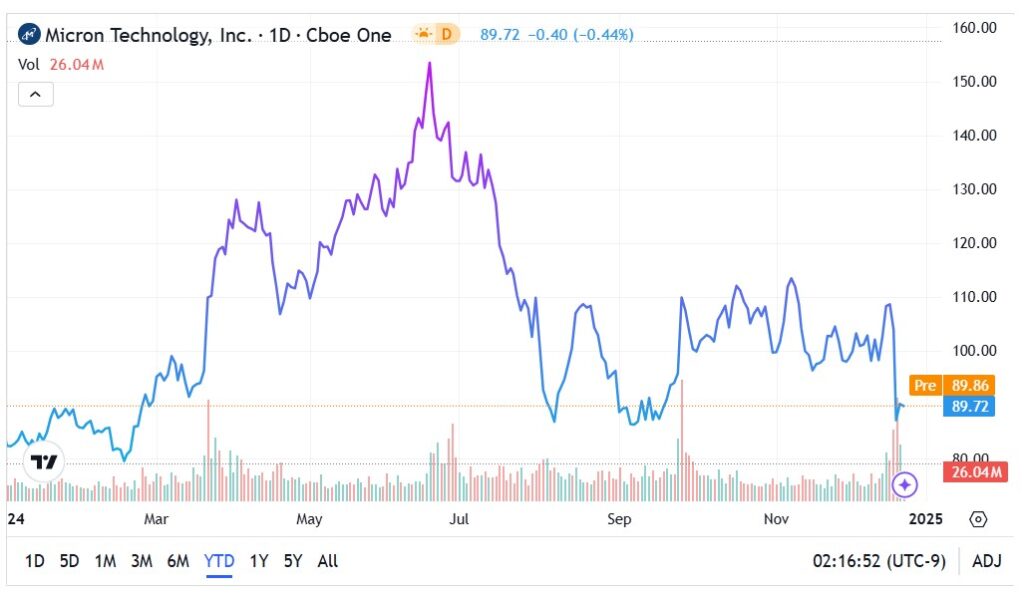While computer memory specialist Micron Technology MU fundamentally benefits from the surge in artificial intelligence — largely because of its high-performance memory and storage solutions — MU stock suffered a rude awakening recently.
Last week, shares tumbled almost 15% following the company’s rather disappointing earnings report. Still, astute risk-takers may find upside opportunity in the carnage.
After the market closed last Wednesday, Micron released its results for the first quarter of fiscal 2025. Adjusted earnings per share landed at $1.79, beating the consensus view of $1.76. However, the market didn’t take too kindly to the tech giant generating sales of $8.71 billion, thus missing the expected tally of $8.72 billion.
However, it was likely guidance that sent investors rushing for the exits. Management anticipates that in the current quarter, revenue might land at only $7.9 billion, give or take $200 million. Either way, that’s short of analysts’ estimate of $9 billion. Adding to the woes, Micron expects Q2 adjusted EPS to reach $1.43, plus or minus 10 cents. This figure pales in comparison to the prior estimate of $1.92.

With this trade, MU stock has now fallen back into the clutches of a horizontal consolidation pattern that began in late July of this year. Because of the rarity of one-week drops exceeding 10%, investors have reason to be cautious. Nevertheless, data-driven traders may view Micron stock as a compelling comeback opportunity.
Leveraging the Power of Probabilistic Analysis
In physics, aircraft engineers primarily rely on Newtonian mechanics to design stable airplanes. Essentially, flight dynamics of objects near the earth’s surface can be reliably predicted with classical physics. However, satellites require an Einsteinian model or general and special relativity, in part to account for weaker gravitational fields and other unique dynamics in space.
The financial markets work in a similar manner. Many, if not most, technical analysis indicators are derived through linear, deterministic (i.e., Newtonian) frameworks. They monitor the frequencies of a given event over a defined period of time.
For example, under a frequentist approach, it’s straightforward to calculate the probability that, on any given Monday, the market will deliver a positive return by Friday’s close. In this case, the trader divides the number of positive weeks in a given dataset by the total number of weeks in that dataset. The success ratio for MU stock over the past five years is 49.4%.
However, what happened last week is a rare event. Over the same five-year period, there were only nine weeks (not including last week) where MU stock lost 10% or more. Of this figure, six of the following weeks ended in positive territory (or a success ratio of 66.67%), with an average return of 6.22%. These figures can be attained via a probabilistic analysis called Bayesian inference.
At its core, the character of speculation in MU stock changes dramatically following a deep loss of weekly value. Much like Einstein’s theory of relativity accounts for large objects’ disruption of the space-time continuum, Bayesian inferences help capture the sentiment shift of extreme greed that occurs following a period of extreme fear.
Bull Call Spreads of MU Stock to Target
To put it simply, determining the success ratio of any given week is basically a coin toss. However, this week is special because it follows a week where MU stock lost almost 15% of value. Such events are quite rare and when they occur, they tend to shift the fear-greed continuum decisively in favor of the bulls. Of course, that doesn’t guarantee success. However, a trader would be betting with the wind at their back.
Understanding this framework, there are two approaches to consider, both involving bull call spreads that expire this coming Friday (Dec. 27). One idea is to buy the 88/90 call spread or buying the $88 call and simultaneously selling the $90 call. Here, the credit received from the short call helps partially offset the debit paid for the long call.
The net debit paid comes out to $149 (as of Monday’s close), which is the most that can be lost in the trade. Further, the payout is the difference between the strike prices minus the net debit paid, which is $51 or 34.23%.
However, as stated earlier, the Bayesian calculation revealed that when a positive week follows a 10% or greater loss in the prior week, the average return is 6.22%. Applying this figure to Monday’s close reveals an upside target price of $95.30. By logical deduction, an aggressive bull call spread could feature a short call strike of $95.
For instance, an intrepid speculator could buy an 88/95 call spread. That puts $252 at risk for the chance to earn $448 should MU stock hit or exceed $95 by Friday, or a payout of 177.78%. Again, it’s an aggressive bet and the market makers — who are likely using deterministic math — have calculated very low odds of success, hence the big payout.
In contrast, probabilistic math based on special circumstances (such as the current week) yields a completely different framework. This is the inside edge that investors should consider when assessing MU stock amid the earnings aftermath.
Read Next:
Photo: Shutterstock
© 2024 Benzinga.com. Benzinga does not provide investment advice. All rights reserved.